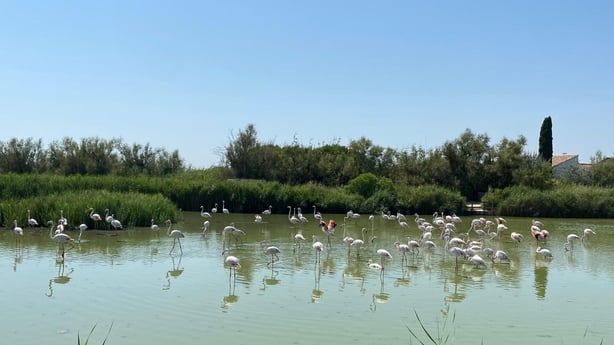Chaith Sarah Ryder agus a clann saoire le déanaí i ndeisceart na Fraince áit ar thapaíodar deis cuairt a thabhairt agus iad ann ar thearmann dúlra an Camargue.
Ever since reading a children's book about the Camargue, it had been a dream of mine to see that part of France. And finally, this summer, on a road trip from Cassis to Carcassonne, I got to finally experience this most unique of European landscapes.
Machaire mór cothrom is ea an Camargue; deilt ceann de mhór aibhneacha na Fraince, an Rhone, áit a bhfuil guairí gainnimhe tar éis comhcheangail thar tréimhse le locha móra uisce sáileach a chruthú, agus eiceachóras aonaránach dochreidthe a thógáil atá ina thearman plandaí agus fiadhúlra neamh-ghnáth.

We followed the Rhone to the sea, passing vineyards, through sleepy white-stoned towns until we hit a brutal industrial landscape where the main branch of the Rhone meets the Mediterranean. We skirted round it, and turned inland to nature once more, crossing over a branch of the Rhone – the Petit Rhone – on a charming local car ferry known as the Bac du Sauvage Bac du Sauvage - Wikipedia.
Once across the river, the landscape became a riot of colour: golden grasses, bright yellow sunflowers, the lurid green of the paddy fields where the famous Camargue red rice is grown. The Superfood from France: Camargue Rice | Taste France Magazine. And every so often we’d catch a glimpse of the elegant white horses the region is famous for, or a giant bird would swoop majestically over the car.

Our destination was a nature reserve on the Étang de Gines, the Parc Ornothologique du Pont de Gau (Welcome | Parc Ornithologique du Pont de Gau) to see the flocks of wild flamingos who have made the delta their home. It was 36 degrees when we pulled into the car park, so with hats on, water bottles filled and suncream applied, we set off into the park.
Tá dhá bhealach go bhféadfá leanúint thart ar na locha; ciorcal 2.6km gur féidir 4.3km breise a chur leis má tá tú in ann don teas. Bhí folacháin ann le bheith ag breathnú ar na héanlaithe - agus éalú ón ngriain - agus go leor pontúin agus ardáin réamh-déanta le bheith ag féachaint ar na lasairéin, na n-éigrit agus na corr réisc. Bhí sách eolais ar fáil fé na spéiceas éagsúla atá tar éis cur fúthú ann nó iad siúd a thaistealaíonn trén áit ar a mbealaigh ó thuaigh le pórú. Insíonn clár dubh ag an bealach isteach an líon éin agus spéiceas atá le feiceáil sa pháirc lá ar bith.

The day we visited, 563 flamingos were hanging out in the park’s lakes. And we were not disappointed: we stood by the lakes watching the elegant pink birds chatter and forage. And marvelled as they took off, their giant wings unfurling to reveal the pink and black feathers which define the Greater Flamingo of the Camargue. A magical experience, and a childhood dream come true.
But there were other elegant avian giants to see too, from several different species of heron to the regal white egret. In winter and spring the park will become a resting place for many migrating bird species; it is definitely a place to visit year-round. The children were fascinated by a pair of nesting egrets who were perched on a disastrous-looking heap of twigs between two trees.

"Why are those birds fighting mum?" said one as one partner returned to feed a nest of squawking chicks. "Their house doesn’t look too safe," said the other. After a cooling drink in the park’s little café, we drove 30 km north to Arles, a city of Roman ruins, plane trees, art and history; where Picasso, Gaugin and Van Gogh painted some of their most renowned works. And you can see why.
Tá rud éigin draoíchtúil faoi Arles. Seans gurb í an teas é, a chuireann ort maoiliú agus an saol a ghlacadh ar luas níos séimhe. Nó cearnóga leathan, duilleogach áit nach bhfuil aon dul as agat ach bheith id shuí ag breathnú ar an saol ag dul thart. Nó an abhainn ollmhór agus na hiarsmaí Rómhánacha a chuireann i gcuimhne duit nach ionat ach blip ar raon-ama na cathrach ársa seo. Beimid ar ais i gcúinne seo na Fraince arís.
As we drove around, we spotted lovely stone farmhouses, vineyards and gites offering beds for the night; I suspect we will be furiously googling them this winter to plan our next trip to soak up the colours, sounds, heat, tastes and perfumes of the Camargue once more.
